An Intro to Basil
MY STATUS: Grown Successfully to HarvestBasil is an annual herb that thrives in hot, dry places.
FEED IT
Unlike many of the other common herbs, it loves rich soil with lots of organic matter and fertilizer. You're not going to want to plant basil in Pohnpei's natural soil, which has a high PH, unless you balance things out with lots of compost and manure. The more basil gets fed, the more it grows.
MMMM, SUN!
Basil is also a sun-lover, and most sources say it will do best with maximum sunlight--8+ hours a day. On Pohnpei 8 hours of sun is an impossibility, but if you plant your basil in a pot, you can keep it in the sun as much as possible.
ROOM FOR ROOTS
You should use a big, deep pot, because basil develops deep roots.
KEEP IT DRY
Basil likes dry soil. Keep it out of the rain, and water once or, at most, twice a week (depending on how much sun there is).
PICK LIKE CRAZY
The final thing to remember with basil is that it dies once it flowers and goes to seed, but you can prolong the life of the plant by systemically stressing it. You do this by keeping the plants picked of all of their leaves except for 2-3 at the base. This encourages the plant stem to thicken and put out more leaves. If any flower buds develop, they should be picked off immediately. I'm curious to know how long you can do this in a place like Pohnpei without major seasonal changes.
What I Did
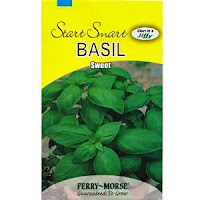 For me, basil was the beginning. This was by far the most desired herb of all the ones I bought seeds for in California. I had two varieties: Sweet Basil and Lemon Basil. Both were from the Ferry-Morse Start Smart series ($1.59) and were purchased at Home Depot in Southern California about a week or so before I started planting.
For me, basil was the beginning. This was by far the most desired herb of all the ones I bought seeds for in California. I had two varieties: Sweet Basil and Lemon Basil. Both were from the Ferry-Morse Start Smart series ($1.59) and were purchased at Home Depot in Southern California about a week or so before I started planting. I was pretty pessimistic and/or naive at the beginning and I guess I thought only a small percentage of the seeds would germinate. So, rather than just plant a few seeds, I used ALL the seeds in BOTH packages! Yikes. If I'd only known what would happen in just 48 hours!
I was pretty pessimistic and/or naive at the beginning and I guess I thought only a small percentage of the seeds would germinate. So, rather than just plant a few seeds, I used ALL the seeds in BOTH packages! Yikes. If I'd only known what would happen in just 48 hours!DAY 1 - SOWING
Sowing was simple. I filled all 12 sections of my paper egg container with garden soil purchased at Pohnpei Ace Hardware. I sprinkled the Lemon Basil seeds into six of the cups and the Sweet Basil into the other six and covered them up. Done. If I did this again, I'd just put a few seeds in one cup and refrigerate the rest for the next crop.
DAY 2
DAY 3 - GERMINATION
Surprise surprise! In the morning only 48 hours after seeding there were already seedlings pushing up. That's about half the minimum time the package said it would take--5-10 days.DAY 5
By the morning of the 5th day, all cups were crowded with 20+ seedlings all growing at roughly the same rate. It looked like pretty much every seed germinated (right).DAY 7 - TRANSPLANTATION
SOIL PREPARATION & PLANTING:
- I had so many seedlings that I decided to create both indoor and outdoor pots for each of the two varieties. My outdoor pots were wide and deep.
- I put two inches of coarse basalt gravel in the bottom for good drainage.
- Next, I added a balanced mixture of steer manure, local dirt, garden soil, and Miracle Grow Compost Mix.
 I carefully removed the dirt from a couple of the cups and gently separated out the seedlings. There were about 25-30 to choose from for each variety, so I picked the largest ones with the best leaves and the most root development. Survival of the fittest.
I carefully removed the dirt from a couple of the cups and gently separated out the seedlings. There were about 25-30 to choose from for each variety, so I picked the largest ones with the best leaves and the most root development. Survival of the fittest. - The package said to plant the seedlings 10 inches apart, but I read plenty of recommendations online that suggested that they could be twice as crowded and still do great. I planted my seedlings about 1/4 inch deep and 4-5 inches apart. In the most extreme scenario, if they grow really big and crowd each other, I can always cut a couple of them off at soil level. I'd rather start with more and then weed out the weaklings as time goes on.
DAY 16
All four pots with basil plants in them are doing great, although success seems proportional to pot size. The ones in the largest pots are certainly growing the fastest (left: lemon basil with one mature set of true leaves, young second set + cotyledons).Most of the plants are developing their second set of true leaves. They are looking lush, robust, healthy. I planted about 25 plants for each of the two varieties. I think there were only 1-2 seedlings that didn't look like they were doing as well as the others. I pulled those out (right: sweet basil with one mature set of true leaves + cotyledons).
DAY 25
Both varieties of basil have three sets of true leaves.DAY 26 - LEAF HARVESTING
DAY 28
The experimental leaf harvesting paid off! I have all sorts of new leaf growth even though the weather hasn't been cooperating. Over the previous 4 days, I have a sunny success rate of only about 25%. Not awesome for these little guys, but they seem to be handling it well (below: lemon basil with new growth).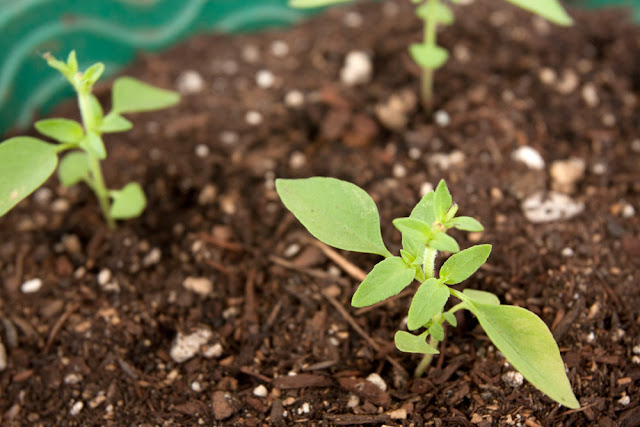
DAY 29 - PRUNING
I had such success with the early leaf harvesting, that I decided to give all my plants a pretty harsh pruning. I removed all but the lowest two leaves and snipped off the top of the central stem to encourage my basil to grow outward instead of up (below: sweet basil a day after pruning).
DAY 31 - APPLICATION OF FISH EMULSION
I fertilized all of the basil plants with Alaska Fish Emulsion fertilizer. Stinky stuff. Smells like bad diarrhea. Hopefully the plants will like it more than I do (below: sweet basil plants).DAY 57
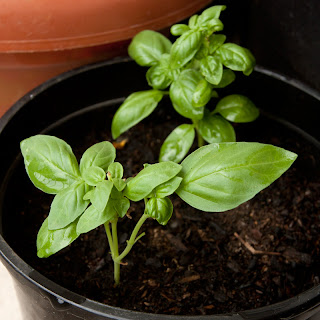 |
 |
DAY 58 - PRESTO PESTO!
Today I had enough leaves on my plants for my first batch of pesto! I harvested all the leaves except for two near the base of each plant and threw them all in the food processor with some fresh garlic, oil oil, and asiago cheese (below).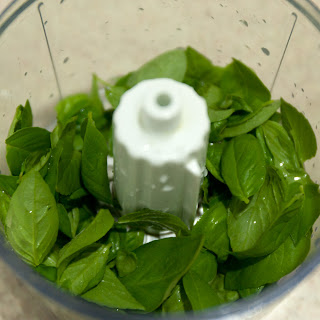 |
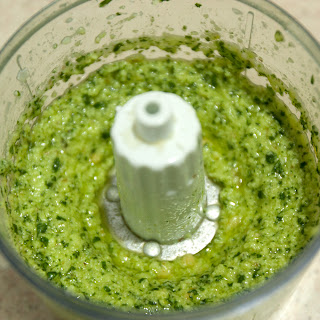 |
DAY 74 - EASY STREET
I can't say I'm doing anything particularly technical with my 20+ basil plants. They seem to thrive pretty much no matter what happens. The one thing I am doing is keeping them picked of all but a few leaves and systematically pruning the branches. After a harsh picking it usually takes about a week for the plants to be ready for harvest again.The pruning protocol goes like this: New leaves develop at the intersection of a major branch and a secondary branch (or leaf). Any leaf stem will lengthen and become a branch if the plant's nutrients are diverted to it. You do this by clipping off a main branch above one of these intersection points. That stops the branch from growing longer, and instead, the leaf stems below the cut become new branches. If you do this carefully, you can increase the number of branches exponentially, creating a nice bushy plant. The more branch intersections, the more leaves a plant can have. It has worked really, really well and I would say it is the number one factor contributing to my plants' success.
 |
 |
DAY 77 - SECOND PESTO BATCH
As my plants grow bigger, they are starting to get a little crowded. I've been slowly transplanting them into their own containers. I try to move them without disturbing the roots much, but even so it takes a few days for them to settle in to the point where they are comfortable in direct sun again.Made my second batch of pesto today. I was able to get many more leaves out of this harvest than the last one. SO yummy! Even the kids loved it. :)
 |
 |
DAY 95
I made my third batch of pesto today. The harvest was nearly double what it was the last time--18 days ago. I'm keeping the plants on the roof now under a clear-plastic shelter, so they are getting the maximum sun we get here. They're loving it! Inch-long leaves develop in just 48 hours.DAY 152 - BASIL MONSTER
I have transplanted a number of both the sweet basil and lemon basil plants into their own pots to give the others more room. All plants are producing leaves at such a rate that we really can't find enough uses for them (the sweet basil plants produce about 3 tightly-packed cups of leaves in 5 days). I no longer bother to pick leaves off the plants carefully. Now I just take the scissors and hack a few inches off the top once a week. These guys are pretty thirsty, too. Now that they live in the little rooftop shelter and get maximum sun, they drink up a lot of water. The lemon basil tends to get out of hand faster than the sweet basil; the leaves are smaller and multiply quicker and I also find fewer uses for this variety, even though we put it in salads, meat dishes, on sandwiches, in soups and stews, and in tomato sauce. So far I haven't let the sweet basil get to the point of flowering, but on a couple of occasions I've found buds on the lemon basil (I snipped them off).DAY 211 (9/5) - LEMON BASIL TRYING TO GO TO SEED
Blistering hot temps (sometimes in the mid-90s) through the summer have pushed the Lemon Basil to flower. Flower buds have been appearing from time to time for a few weeks. I pinch off any I see, but it's hard to keep up. They want to go to seed. The plants are still producing lots of leaves and the flavor hasn't suffered at all. The plants are so big that I have to keep them outside the garden shelter now, under the eaves. I've seen no flowering with the Sweet Basil, which is more tolerant to heat. I created a number of sweet basil clones not too long ago to keep things going. It's probably time to do the same with the Lemon Basil.The Sweet Basil continues to produce leaves at a rate I can't keep up with. I get about 4 packed cups of leaves twice weekly.






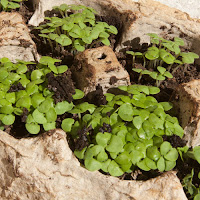




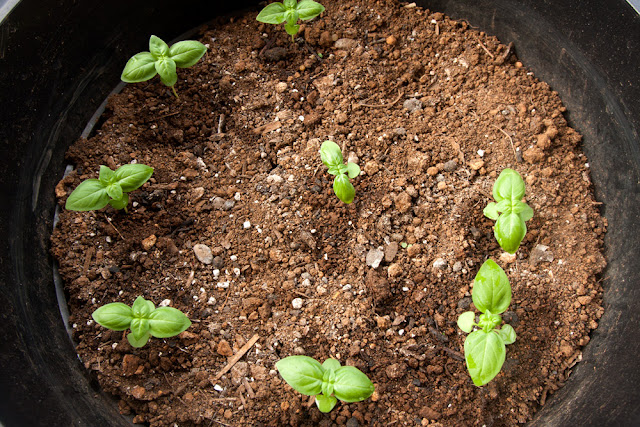


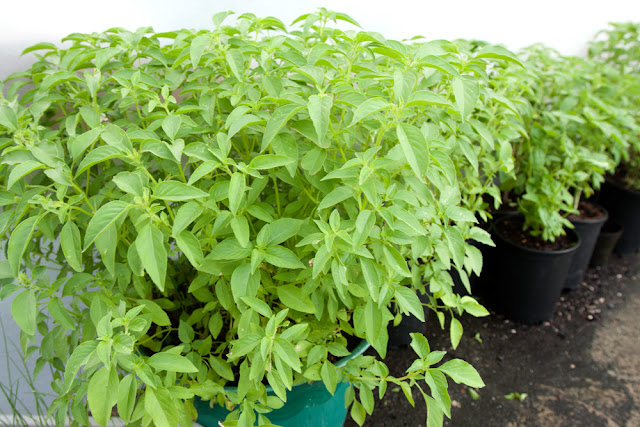
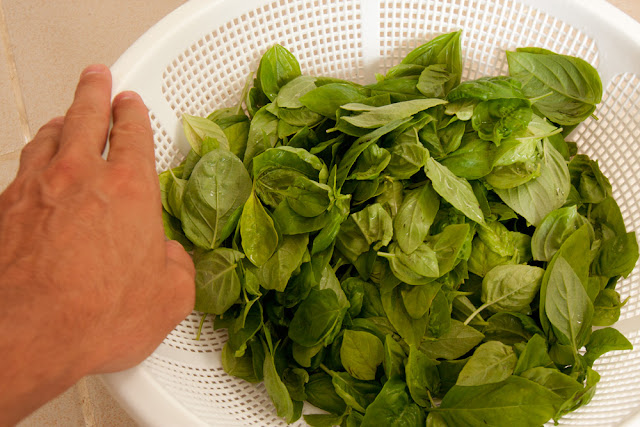


.jpg)







0 comments:
Post a Comment